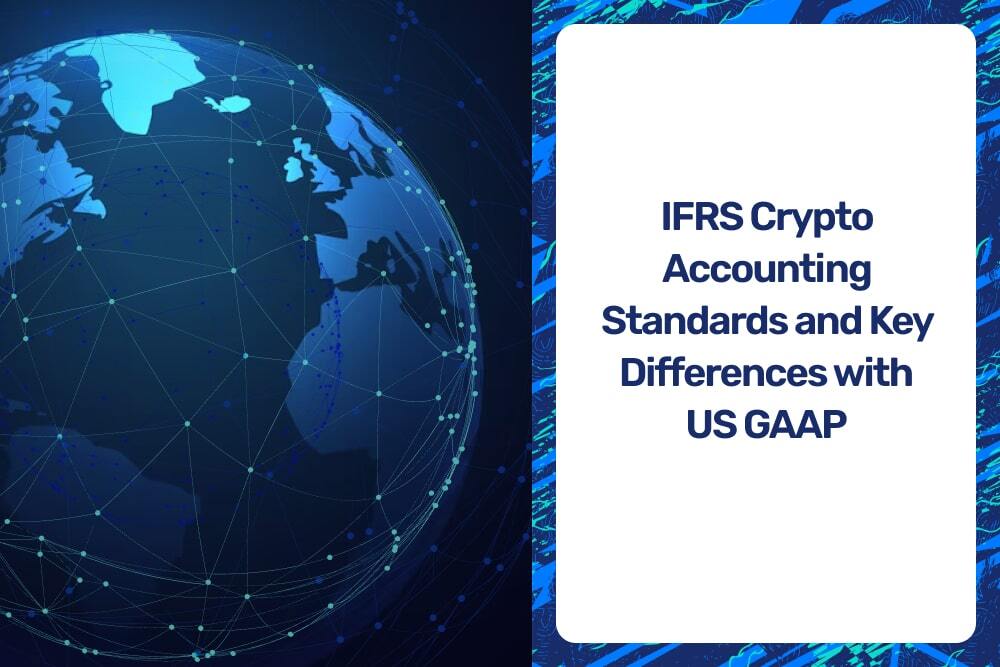Understand the accounting treatment of cryptocurrencies under IFRS standards and the key differences with US GAAP
As cryptocurrency continues to gain mainstream popularity, accounting for this asset class is incredibly challenging and time-consuming. The International Financial Reporting Standards (IFRS) and the United States Generally Accepted Accounting Principles (US GAAP) are the two most widely adopted accounting frameworks that govern how cryptocurrencies are recognized, measured, and disclosed in financial statements. This article explores the accounting treatment of cryptocurrencies under IFRS standards and highlights the key differences with US GAAP.
Recognition of Cryptocurrencies
Under IFRS standards, there is no prescriptive guidance on how to account for cryptocurrencies specifically. Without tailored guidance, the accounting for cryptocurrencies could follow several different accounting models, including cash, financial instruments (IAS 32), or inventory (IAS 2). Because of this, companies must consider all the facts and circumstances when determining the appropriate accounting treatment. For example, cryptocurrencies held for trading purposes (or as part of the broker-trader exception) could be recognized as inventory and accounted for at fair value, with any changes in value flowing through profit or loss on the statement of financial position.
While various models exist, the most common model to account for cryptocurrencies under IFRS is to treat them as intangible assets. This treatment follows the guidance in IAS 38 and requires that assets meet the definition of an identifiable non-monetary asset with no physical substance. Due to the nature of cryptocurrencies, this is the approach most commonly followed under IFRS. Under this model cryptocurrencies are initially recognized at cost and subsequently measured using one of the two options discussed below.
Under US GAAP, cryptocurrencies are not specifically addressed in the accounting standards. Consequently, companies must apply the principles of other relevant accounting standards, such as ASC 305, Cash and Cash Equivalents, ASC 330, Inventory, or ASC 350, Intangibles, depending on the nature of the cryptocurrencies. This lack of specific guidance can lead to diversity in accounting treatments among US companies. While multiple reasonable models exist, industry practice led by the AICPA’s Digital Asset Working Group has evolved and consolidated around accounting for cryptocurrencies as intangible assets under ASC 350.
Measurement of Cryptocurrencies
The measurement of cryptocurrencies is another area where IFRS and US GAAP differ significantly today. IFRS requires cryptocurrencies held for trading to be measured at fair value through profit or loss, providing users with up-to-date information about their market value. Changes in the fair value of cryptocurrencies are recognized in the income statement, enhancing transparency and reflecting the true economic impact of holding these assets.
For cryptocurrencies accounted for as intangible assets, IFRS does not prescribe a specific measurement model. Instead, companies have the option to apply one of two measurement approaches: cost or revaluation. Under the cost approach, companies measure their crypto holdings at cost less accumulated amortization or impairment losses. Any impairment event will result in an impairment expense being recognized and a corresponding write-down of the value of the crypto holding on a company’s balance sheet. Under the revaluation method, companies are allowed to recognize their crypto holdings at fair value as long as an active market exists where the assets can be traded. The nuance of this approach requires companies to track the original cost and record any movements below cost to profit and loss, whereas any movements in value above cost are recorded in other comprehensive income.
Under US GAAP, the measurement of cryptocurrencies varies depending on how they are classified. If a cryptocurrency is treated as part of the broker-dealer guidance, it would be measured at fair value through earnings, akin to IFRS trading treatment however, if a cryptocurrency is deemed an intangible asset – which is the prevailing market treatment – US GAAP follows a historical cost approach under ASC 350. This approach requires companies to hold crypto assets on their balance sheet at cost, less impairment. This means that any time the price of an asset dips below its acquisition price, a company would need to recognize an impairment expense and corresponding reduction in the value of the asset. This impairment tracking and analysis must be performed at the individual lot level to make matters more complex.
In summary, most companies following IFRS will use the revaluation model and recognize crypto assets at their fair value, whereas companies following US GAAP must use a cost-plus impairment model. This leads to significant differences in the resulting financial statements for companies using IFRS versus US GAAP.
Impairment of Cryptocurrencies
As mentioned above, impairment testing is an important aspect of accounting for cryptocurrencies, as their volatile nature can lead to significant fluctuations in value over short periods. Under IFRS, unless a company uses the revaluation model, they need to assess whether there are any indicators of impairment for cryptocurrencies accounted for as intangible assets at each reporting date. If indicators of impairment exist, the company must perform a recoverability test by comparing the carrying amount of the asset to its recoverable amount, which is the higher of fair value less costs to sell.
If the recoverable amount is less than the carrying amount, an impairment loss is recognized in profit or loss for the difference. Impairment losses for cryptocurrencies accounted for as financial assets held for trading are also recognized in profit or loss.
In contrast, US GAAP follows the guidance of ASC 350, for the impairment testing of cryptocurrencies considered to be intangible assets with indefinite lives. Under this standard, a two-step approach is used, where the carrying amount is compared to the fair value. If the carrying amount exceeds fair value, an impairment loss is recognized.
Accounting Methodologies
Inventory accounting methodologies play a significant role in both IFRS and US GAAP, impacting the valuation and cost allocation of inventories, including those involving cryptocurrencies. Under IFRS, inventories are primarily valued using the weighted average cost method or the first-in, first-out (FIFO) method. The weighted average cost method calculates the average cost of all similar items in inventory and applies this average cost to each unit sold or in ending inventory. This approach ends up being calculation intensive for companies dealing with a high volume of crypto activity. On the other hand, the FIFO method assumes that the first items acquired are the first ones sold, leaving the most recent purchases as part of the ending inventory balance. This subtle difference in cost allocation can lead to variations in profit and inventory value depending on the fluctuations in purchase prices.
Similarly, US GAAP allows companies to choose from several inventory accounting methodologies, including specific identification, FIFO, and weighted average methods. The specific identification method assigns the actual cost of each individual unit of inventory to the corresponding unit sold, allowing for precise cost allocation but often limited to items with distinguishable characteristics or high value. The FIFO method in US GAAP mirrors that of IFRS, where the earliest inventory purchased is assumed to be the first sold, while the weighted average method takes the average cost of all inventory items and applies it to the units sold. The FIFO methodology is by far the most common approach under US GAAP. This is largely due to its relative simplicity and the ability to treat inventory in a programmatic manner.
In the context of cryptocurrencies specifically, companies face unique challenges in tracking inventory due to the complexity of tracking individual units – or lots. In order to appropriately calculate realized gains and losses, and track unrealized positions, companies must have the ability to identify and track individual lots and the corresponding lot details, cost basis, book value, and fair value – along with any lifecycle events such as transfers and impairment. As the crypto market remains highly volatile, this adds to the complexity. Therefore, companies must carefully consider the nature of their crypto inventory and select the most appropriate inventory accounting methodology under both IFRS and US GAAP to ensure consistent and reliable financial reporting.
US GAAP Changes Will Better Align With IFRS
The upcoming changes for US GAAP moving towards a fair value model represent a significant shift in how cryptocurrencies are valued and reported in financial statements. Under the current cost-based model, companies often face challenges in accurately capturing the dynamic market values of cryptocurrencies, leading to potential impairment issues and mismatches between reported values and their true economic worth. However, the transition to a fair value model aims to address these concerns and better align US GAAP with IFRS standards.
By adopting a fair value approach, US GAAP will closely mirror the IFRS treatment of cryptocurrencies, bringing consistency and comparability to financial reporting on an international scale. Under the fair value model, cryptocurrencies will be measured at their market value on the balance sheet date, with any changes in fair value being reported in earnings. This will place increasing importance on how companies calculate fair values and the inputs to those measurements while eliminating the need for impairment testing, as any fluctuations in the market value will be immediately recognized in financial statements, thereby presenting a more accurate view of their economic value. In addition to these changes, companies will be required to disclose additional information about their crypto asset holdings and activity. These changes will provide better insights and more transparency into a company’s crypto portfolio and will enable stakeholders and investors to make informed decisions.
Furthermore, the fair value model’s better alignment with IFRS will foster greater international collaboration and investment. As companies report their cryptocurrency holdings using a uniform valuation method, it will become easier for investors and other stakeholders to assess the financial health and performance of entities operating in diverse jurisdictions.
In summary, the transition of US GAAP towards a fair value model for cryptocurrencies will mitigate impairment issues and enhance consistency with IFRS standards. This change will provide more relevant and up-to-date information, better reflecting the true economic value of cryptocurrencies in financial statements and fostering greater harmonization in international financial reporting.
Conclusion
As the adoption of cryptocurrencies continues to grow, understanding the accounting treatment of these assets becomes vital for businesses following either IFRS or US GAAP. The main differences between the two accounting frameworks lie in the recognition, measurement, impairment, and accounting methodologies used to track and report cryptocurrencies. IFRS allows for fair value treatment under a revaluation approach, whereas current US GAAP requires a cost-plus impairment approach.
Upcoming changes to US GAAP will require fair value measurement for crypto assets resulting in better alignment between the two reporting standards. As the crypto space evolves, companies across the globe will continue to look to IFRS and US GAAP accounting standards to set the tone, provide consistency, and establish the rules by which crypto assets are accounted for.
.png)


